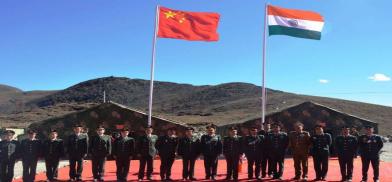India-China border talks: The utopia of disengagement!
The forthcoming SCO Defence Ministers' Meet at New Delhi on April 27-28, followed by the SCO Foreign Ministers Meet in Goa on May 5, and the G20 Summit in September 2023 in New Delhi will have participation by China, where ample scope for bilateral meetings exists. It is high time the Indian defence minister, foreign minister, and prime minister discuss the issue directly with their Chinese counterparts to determine what exactly the Chinese intentions are.

The 18th round of Corps Commander-level India-China talks in Eastern Ladakh was held on April 23, 2023, on the Chushul-Moldo border. The meeting was apparently sought by India in the vain hope that China would somehow soften its approach towards India and relent. The timing was significant since Chinese Defence Minister Li Shangfu is scheduled to attend the Shanghai Cooperation Organisation (SCO) Defence Ministers' Meet in New Delhi on April 27-28, this being the first visit of a Chinese defence minister to India after the Chinese invasion of Eastern Ladakh during 2020, the violent Galwan Clash on June 15-16, 2020 between the Indian Army and the People's Liberation Army (PLA), and the continuing standoff along the Line of Actual Control (LAC) between the two countries over the last three years.
A statement issued by India's Ministry of External Affairs (MEA) the next day, April 24, stated that the two sides had a frank and in-depth discussion on the resolution of the relevant issues along the LAC in the Western Sector so as to restore peace and tranquillity in the border areas, which will enable progress in bilateral relations. Unlike earlier, this was not a joint statement issued by both countries. The statement further said that in the interim, the two sides agreed to maintain security and stability on the ground in the Western Sector. The two sides agreed to stay in close contact and maintain dialogue through military and diplomatic channels and work out a mutually acceptable resolution of the remaining issues at the earliest.
There was no breakthrough as expected. The diplomatic jargon used in the MEA statement is similar to the MEA statement issued after the 17th round of talks held on December 20, 2022 – all gas and no substance. China has been using the talks to consolidate its positions in the new locations occupied in 2020, deploying more weaponry, drones and robots, and long-range artillery, constructing high observation towers, improving communications and positioning troops of Tibetan descent to improve PLA functioning in high-altitude terrain.
No levers to bargain
The two newly constructed bridges on Pangong Tso improve PLA's offensive capabilities in Ladakh. China has been conducting exercises with helicopters in the region, is regularly flying surveillance drones, and has deployed stealth radars in the region, including at Pangong Tso. To hope that China would back off is naïve, especially since we vacated the Kailash Range in our own territory without even linking a Chinese withdrawal from Depsang and Demchok. We have no levers to bargain and China is holding all the aces. To top this, India is annually benefiting China with over $100 billion through the balance of trade.
In his third term as China’s president, Xi Jinping should be expected to be more aggressive than before. The PLA has been flexing muscles in Arunachal Pradesh as well, while Beijing has announced a second highway through Aksai Chin that would be running close to Galwan, Hot Springs and Pangong Tso. China has released a third list of names of 11 places in Arunachal Pradesh in Chinese, Tibetan and Pinyin characters. Xi has been exhorting the PLA to prepare for “actual” war.
The logic that the resolution of the Sumdorong Chu intrusion by China bordering Tawang district in Arunachal Pradesh during 1986-1987 and the subsequent standoff took a series of rounds of talks amounts to clutching straws because the matrix in Eastern Ladakh is totally different; the PLA has fully consolidated in the new locations occupied in Eastern Ladakh with no intent to withdraw further and we are not holding heights overlooking Chinese positions as was the case in Sumdororong Chu. Moreover, Xi views India to be in the American camp, which is not to his liking.
Multiple leaders' meetings
Under the circumstances, continuing with military-to-military talks and staring at the poker faces of Chinese faces for hours knowing the outcome is downright stupid and somewhat embarrassing. India's External Affairs Minister S Jaishankar has met China’s Wang Yi multiple times since 2020 – both in India and abroad. Prime Minister Narendra Modi also met Xi Jinping at the G20 Summit in Bali last year.
The forthcoming SCO Defence Ministers' Meet at New Delhi on April 27-28, followed by the SCO Foreign Ministers' Meet in Goa on May 5, and the G20 Summit in September 2023 in New Delhi will have participation by China, where ample scope for bilateral meetings exists. It is high time the Indian defence minister, foreign minister, and prime minister discuss the issue directly with their Chinese counterparts to determine what exactly the Chinese intentions are.
(The author is an Indian Army veteran. Views are personal.)









Post a Comment